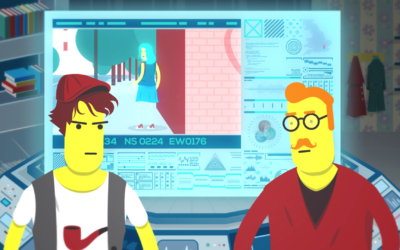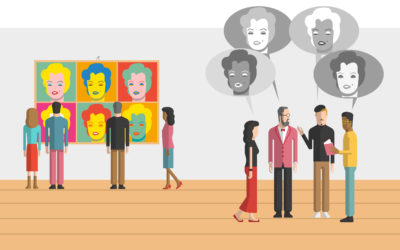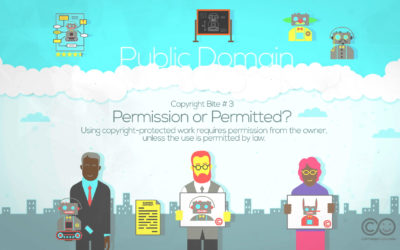Parody & Pastiche
Author: Kris Erickson
Illustration: Davide Bonazzi
Parody refers to a new creative work which uses an existing work for humour or mockery. Some parodies take aim at well-known artists or their work in order to make a critique. Another kind of parody uses existing work to draw attention to or comment upon a particular social phenomenon or issue. What all parodies share is referencing and making use of existing work to generate new social commentary.
Obviously, parodists must carefully consider copyright, because most parodies require taking aspects of an original work in order to conjure it in the minds of the audience. For example, would any Gangnam Style parody be complete without the iconic ‘horse dance’ from the original music video?
UK legislation
UK Copyright Law, implementing the EU Copyright Directive, provides an exception to copyright ‘for the purposes of caricature, parody or pastiche’. This means that in principle it is possible to create parodies that re-use works protected by copyright without having to obtain permission from the rightsholders. However, it is important to note that the use of copyright works for parody purposes is only allowed insofar as it can be considered ‘fair dealing’. How much copying from a work is fair or unfair is an issue ultimately decided by a court of law taking into account the interests and rights of the copyright owner as well as the freedom of expression of the person relying upon the parody exception. In making this decision, a court will typically take a number of different factors into account, such as the amount of the work that has been copied.
According to the UK government, under this copyright exception, ‘a comedian may use a few lines from a film or song for a parody sketch; a cartoonist may reference a well known artwork or illustration for a caricature; an artist may use small fragments from a range of films to compose a larger pastiche artwork’; whereas ‘it would not be considered “fair” to use an entire musical track on a spoof video’. You can find the government’s guide on exceptions to copyright for ‘Caricature, Parody or Pastiche’ here.
Another important element of the legislation is that contractual terms seeking to prevent or restrict the making of parodies permitted under this exception are ‘unenforceable’ in law. In other words, the parody exception cannot be overridden by contract. This means that you may still be able to make a parody of something, even if other terms and conditions imposed by a platform owner or publisher would otherwise restrict your use of the underlying source material.
UK Copyright Law also gives creators moral rights, such as the right not to have their work subjected to ‘derogatory treatment’ (often referred to as the right of integrity). Therefore, if humorous or satirical use of a copyright work amounts to ‘derogatory treatment’ as defined by law, rightsholders may still take legal action against the parodist.
There are four broad principles to consider with respect to copyright and parody:
1. Permission should be sought when possible
A parody will not infringe copyright if the parodist has secured the permission of the rightsholder. Note that the author or artist is not always the rightsholder – it may be a publishing company or a music label. Seeking permission from these entities can be a costly and time-consuming process, and this may discourage small-scale parodists. However, with permission secured, you are free to parody the work within the bounds of the agreed licence, without risk of infringement.
A problem facing some parodists is that the original creator or rightsholder may not wish to have their work parodied in a negative way, and may therefore refuse permission to use their work. However, just because permission has been refused, this does not mean that you cannot make use of the work for parody purposes. Even if the rightsholder has expressly refused their permission, you are still entitled to rely on the exception for parody so long as your use of the work is fair.
2. Consider the substance of work copied
In considering whether an unlicensed parody has infringed the copyright of the creator, courts in the UK will consider the importance (substantiality) of the copied portions of the work for the original piece as a whole. For example, a parody of a fashion magazine that copied the cover pixel-for-pixel and simply added a moustache to the model, might be found to take too much of the original work and therefore be infringing. A parody that evoked a fashion magazine cover without using the same text, typeface, or photograph of the original magazine is unlikely to be found infringing. In no case is it acceptable to copy something in near entirety and use parody as an excuse – the spirit of parody is the creation of new work and social commentary.
Remember that many parodies will be composite works. For example a commercial music video consists of a music recording, composition, lyrics, performance and cinematographic video. Copying even one of these elements can constitute infringement, meaning that it does not comply with copyright law. A completely new video recording may be removed from YouTube if it contains clips from a music track belonging to a rightsholder who objects to the use. By avoiding direct copying of a sound or video recording, parodists can avoid having their work removed from services like YouTube, even though the indirectly copied elements (such as musical notes of a composition) may still be infringing.
3. Commercial harm
Another thing that UK courts will consider when evaluating whether an unlicensed parody is infringing is the potential for economic harm to the original rightsholder as a result of the new parody. A critical art project, hanging in a university gallery, is unlikely to compete economically with the target of the parody in the commercial marketplace. On the other hand, a fan-made parody of Electronic Arts’ hit game The Sims, which similarly allows players to manage a group of virtual beings, might encroach on the video game publisher’s legitimate market for such a game.
Because this permitted ‘derivative’ use of copyright material applies only to parody and not to other uses such as karaoke, choreography or remix, it is important that would-be parodists have a very clear understanding of the purpose of their use of an original work and the target of the critique that they wish to make, while at the same time minimising the amount of work directly copied from an original. If the parody is to be used in any commercial fashion, it is strongly advised to seek the permission of the rightsholder for use of the underlying work.
4. The importance of freedom of expression
There is broad recognition in the UK and other countries that the free speech aspects of critical parody must be encouraged and enabled, while at the same time respecting the rights of copyright owners. Indeed, the European Court of Justice has expressly acknowledged that the use of work protected by copyright for the purposes of parody is justified by the right to freedom of expression (see Legal Language below).
Legal language:
Johan Deckmyn and Vrijheidsfonds VZW v Helena Vandersteen and Others, Case C-201/13, Court of Justice of the European Union (CJEU), 3 September 2014ing of any act which would otherwise be permitted by this paragraph, that term is unenforceable.’
In this judgement the Court of Justice of the European Union noted that Article 5(3)(k) of the Copyright Directive ‘must be interpreted as meaning that the concept of “parody” […] is an autonomous concept of EU law’; and that ‘the essential characteristics of parody, are, first, to evoke an existing work, while being noticeably different from it, and secondly, to constitute an expression of humour or mockery. The concept of “parody” […] is not subject to the conditions that the parody should display an original character of its own, other than that of displaying noticeable differences with respect to the original parodied work; that it could reasonably be attributed to a person other than the author of the original work itself; that it should relate to the original work itself or mention the source of the parodied work.’
‘However, the application, in a particular case, of the exception for parody […] must strike a fair balance between, on the one hand, the interests and rights’ of authors and other rightsholders ‘and, on the other, the freedom of expression of the user of a protected work who is relying on the exception for parody, within the meaning of Article 5(3)(k).’
‘It is for the national court to determine, in the light of all the circumstances of the case in the main proceedings, whether the application of the exception for parody […] on the assumption that the drawing at issue fulfils the essential requirements of parody, preserves that fair balance.’
Legal References:
Directive 2001/29/EC on the harmonisation of certain aspects of copyright and related rights in the information society:
http://eur-lex.europa.eu/LexUriServ/LexUriServ.do?uri=OJ:L:2001:167:0010:0019:EN:PDF
The UK law on copying works for the purposes of caricature, parody or pastiche is set out in Section 30A and Schedule 2 (2A) of the Copyright, Designs and Patents Act 1988. You can read these provisions here: http://www.legislation.gov.uk/ukdsi/2014/9780111116029
The ‘Right to object to derogatory treatment of work’ is provided by Section 80 of the Copyright, Designs and Patents Act 1988: http://www.legislation.gov.uk/ukpga/1988/48/section/80
Copyright and the Economic Effects of Parody: An Empirical Study of Music Videos on the YouTube Platform and an Assessment of the Regulatory Options, by Kris Erickson, Martin Kretschmer and Dinusha Mendis (2013), available at: https://www.gov.uk/government/publications/parody-and-pastiche
Related
The Game is On! – Ep. 1
In a fictional land called London, Sherlock Holmes and John Watson meet a curious client: the toymaker Joseph …
Quotation
There are two exceptions to be aware of, one specifically for criticism and review and a more general exception for quotation. Both exceptions apply to all types of copyright material…
Copyright Bite #3
Copyright Bite #3 considers how you can lawfully make use of, or borrow from, works that are still in copyright, but without having to ask for permission or make payment to the copyright owner.











